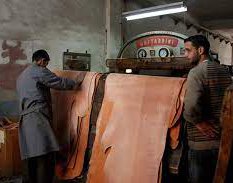Egyptian exports of leather products to the African market increased by about 64% in 2022, to $5 million from $3 million the previous year. One report states that leather tanning accounted for 90% of Egypt's exports of leather products, with a 12% increase in 2022, amounting to $90 million. However, there are 17,600 shoe factories employing more than 230,000 people producing about 100 million pairs of shoes per year along with other leather goods. [Opportunities in leather - Egypt - Al-Ahram Weekly]
Egypt’s exports of leather, shoes, and leather products grew by 16.6 per cent in 2022 to reach around $100 million compared to around $86 million in 2021, according to a report by the Leather, Footwear, and Leather Products Export Council, reports Mai Samih.
Egypt’s exports of leather products to the African market increased by around 64 per cent in 2022 to reach about $5 million compared to about $3 million the year before.
Meanwhile, the report said that leather tanning accounted for 90 per cent of Egypt’s exports of leather products, with an increase in value by 12 per cent in 2022 to record around $90 million.
In a bid to increase the exports of other areas of the leather industry such as final products and to increase the number of exporting companies, Minister of Trade and Industry Ahmed Samir is reviewing opportunities to develop the leather products industry in Egypt to meet the needs of the local market and to export to foreign markets.
This can be obtained through integrating value chains in the Egyptian leather industry to produce high-quality products that are able to compete in the domestic and foreign markets, the minister said.
He stressed the ministry’s keenness to attract new investments to the sector and to transfer international expertise to the Egyptian market. This will also come through strengthening cooperation between Egyptian research institutes and private-sector companies to enable the local manufacture of production inputs such as chemicals.
Head of the Chamber of Leather Industries Gamal Al-Samalouti said that there were plans to double the export numbers of last year, especially to the Arab and African countries.
One way of doing this was through more international exhibitions, he said. In January, the Cairo International Leather Fair was attended by 150 foreign buyers and participating delegations from Iraq, Jordan, Sudan, Kenya, Syria, and Palestine among other countries that signed contracts worth LE40 million with participating producers.
Such contracts will increase the volume of trade in the leather industry between Egypt and these countries, Al-Samalouti said, adding that the most important factors in exporting shoes were keeping pace with contemporary fashion lines, marketing efficiency, market access, and product quality.
All these factors are present in Egyptian products, but there is still the need for development and modernisation, he said.
Al-Samalouti said that there were 17,600 establishments employing more than 230,000 people in the sector producing about 100 million pairs of shoes annually along with other leather goods.
One of the biggest problems facing the sector has been a shortage of production inputs, and this has been combined with other problems such as the complexity of licensing procedures for small workshops in residential areas such as in Bab Al-Sheariya and Attaba in Cairo.
Another problem is that the industry lacks trained managers and trainers available to train workers. Al-Samalouti suggested that more industry exhibitions should be organised locally and abroad and technical assistance from international marketing experts sought.
There should also be an expansion of technical and vocational training in the leather industries, he added.



